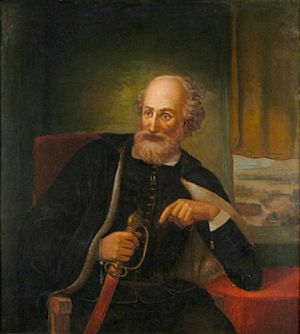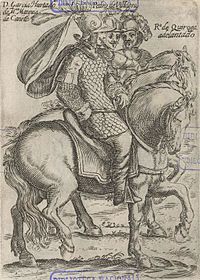Rodrigo de Quiroga facts for kids
Quick facts for kids
Rodrigo de Quiroga
|
|
|---|---|
 |
|
| Royal Governor of Chile | |
| In office 1565–1567 |
|
| Monarch | Philip II |
| Preceded by | Pedro de Villagra |
| Succeeded by | Real Audiencia |
| Royal Governor of Chile | |
| In office 1575–1580 |
|
| Monarch | Philip II |
| Preceded by | Melchor Bravo de Saravia |
| Succeeded by | Martín Ruiz de Gamboa |
| Personal details | |
| Born | c.1512 San Juan de Boime, Spain |
| Died | February 20, 1580 (aged 67–68) Santiago, Chile |
| Spouse | Inés de Suárez |
Rodrigo de Quiroga López de Ulloa (born around 1512 – died February 20, 1580) was a Spanish conquistador from Galicia. He served twice as the Royal Governor of Chile.
Contents
Early Life and Adventures
Rodrigo de Quiroga was the son of Hernando Camba de Quiroga and María López de Ulloa. In 1535, he traveled to Peru. He joined an expedition led by Diego de Rojas to explore a region called Gran Chaco. A year later, he went with a group led by Francisco de Aguirre to Chile. This group later met up with Pedro de Valdivia in Atacama.
Life in Chile
Quiroga took part in many battles during the Spanish conquest of Chile. This was during the first part of the War of Arauco. He became one of the most important leaders in the area. From 1548, he held several important jobs in the government of Santiago. He was mayor three times, among other duties.
He married Inés de Suárez. She was a well-known companion of Pedro de Valdivia. The Viceroy of Peru ordered Valdivia to end their relationship. If he didn't, he faced being removed from the church. So, Inés de Suárez married Quiroga.
After Valdivia died in a battle against the Mapuche people at Battle of Tucapel, people in southern Chile followed Valdivia's wishes and named Francisco de Villagra as their new leader. However, in Santiago, the local council, called the cabildo, chose Quiroga as governor instead. For a while, Chile had two governors: Villagra in the south and Quiroga in the north. This situation ended when Villagra returned from the war zone to claim his right to govern. The cabildo agreed with Villagra, and Quiroga had to give up his power, which he did, though he wasn't happy about it.
In 1565, the Viceroy Lope García de Castro sent more soldiers from Peru. These soldiers were led by General Jerónimo de Castilla. Castilla had orders to arrest Pedro de Villagra (who was Francisco's uncle and had become governor). Quiroga was to take his place. Villagra saw he was too weak to fight for his title, so he gave his power to Quiroga and went to Peru.
First Time as Governor

Quiroga's first real time as governor lasted until 1567. During this period, there were many fights with the native people, and Quiroga's forces often won. Quiroga started a new military plan, organized by Lorenzo Bernal del Mercado. He built forts in places like Lebu and Quiapo. He also rebuilt Cañete and brought people back to Arauco in 1566. He also helped conquer Chiloé Island. He sent his helper, Martín Ruiz de Gamboa, to build the city of Castro there and make peace with the local people, the Cuncos.
Even with these successes, the Spanish court didn't fully recognize his efforts. When he returned to the capital, he found that the Royal Court of Chile had replaced him. For a while, he stepped away from politics and focused on his businesses.
Second Time as Governor
However, in 1575, there was a disagreement between the Royal Court and the governor at that time, Melchor Bravo de Saravia. Because of this, Quiroga was asked a second time to lead the Kingdom of Chile. He officially took his oath in front of the cabildo that same year.
Quiroga's second time as governor was more difficult than the first. Besides the ongoing Arauco War, there were attacks by pirates and two earthquakes in 1575. He also had a disagreement with the bishop of San Miguel about choosing church leaders and reducing their income. This put him in danger of being removed from the church.
Spain promised to send him 500 more soldiers to end the war for good, but only 300 arrived. Also, these soldiers were not as good as hoped and had very little equipment. Despite these problems and his own sickness (he had to be carried to the battlefield in a chair), Quiroga started a new attack against the Mapuches. This time, the Mapuches were led by their chief, or toqui, a mestizo named Alonso Díaz.
This campaign was somewhat successful. This allowed Quiroga to deal with another threat: the arrival of Sir Francis Drake off the coast of Chile. Drake managed to rob the port of Valparaíso. But when he tried to do the same in La Serena, the people fought back, and he was forced to leave.
The 1575 Valdivia Earthquake
On December 16, 1575, a strong earthquake hit southern Chile. It damaged the cities of La Imperial, Villarrica, Osorno, Castro, and especially Valdivia. In Valdivia, the earthquake caused a huge landslide that blocked the water flowing out of Lake Riñihue. Water built up behind this natural dam until it broke, causing a second flood and a big disaster.
Later Life
Quiroga's serious illness made it impossible for him to continue leading the war. He handed this job over to his son-in-law, Martín Ruiz de Gamboa. Quiroga was in bed because of his pain. In his last days, he focused on his religious beliefs. Monks were around him, and he gave most of his belongings to their monasteries. He passed away peacefully on February 25, 1580. His wife, Inés de Suárez, died in the same year.
See also
 In Spanish: Rodrigo de Quiroga para niños
In Spanish: Rodrigo de Quiroga para niños
Sources
| Government offices
|
||
|---|---|---|
| Preceded by Pedro de Villagra |
Royal Governor of Chile 1565–1567 |
Succeeded by Real Audiencia |
| Preceded by Melchor Bravo de Saravia |
Royal Governor of Chile 1575–1580 |
Succeeded by Martín Ruiz de Gamboa |

